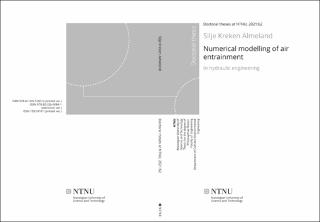| dc.contributor.author | Almeland, Silje Kreken | |
| dc.date.accessioned | 2021-02-18T10:23:43Z | |
| dc.date.available | 2021-02-18T10:23:43Z | |
| dc.date.issued | 2021 | |
| dc.identifier.isbn | 978-82-326-6084-1 | |
| dc.identifier.issn | 2703-8084 | |
| dc.identifier.uri | https://hdl.handle.net/11250/2728889 | |
| dc.description.abstract | Air entrainment in water flows is a natural phenomenon prone to take place when energy is dissipated in flowing water. In nature, air entrainment appears as white water in waterfalls or in waves breaking on the beach. Within this process, air is forced into the water bulk. This results in a very complex flow pattern involving a broad range of time and length scales, which makes it challenging to measure experimentally and to reproduce numerically. In several hydraulic applications, air entrainment plays an important role and needs prediction to ensure safe and efficient operation of the particular structure. Within this work, numerical modelling of air entrainment in water flows has been considered. More specifically, modelling of a stepped spillway and a hydraulic jump is encountered using different approaches for air entrainment modelling and turbulence treatment.
A highly efficient approach, accounting for air entrainment in a subgrid model, was developed and proven to work well for a broad range of stepped spilway flows. The solver was built upon OpenFOAMR ’s VoF solver interFoam in a RANS framework.
Furthermore, a LES approach coupled with interface capturing within the VoF framework, was employed to predict turbulence and air entrainment for the complex flow of a hydraulic jump. In a detailed simulation, the used methodology was shown to reproduce the flow pattern within the hydraulic jump in impressive agreement to corresponding DNS simulations. It thereby proved the predictive capability of OpenFOAMR ’s VoF solvers for this flow.
In light of previously reported lack of proper verification and validation of numerical models within hydraulic engineering, an integral part of the work has also been to consider the more or less crucial influence of changing modelling parameters. | en_US |
| dc.language.iso | eng | en_US |
| dc.publisher | NTNU | en_US |
| dc.relation.ispartofseries | Doctoral theses at NTNU;2021:62 | |
| dc.relation.haspart | Paper 1: Almeland, Silje Kreken; Olsen, Nils Reidar Bøe; Bråveit, Kari; Aryal, Pravin R.. Multiple solutions of the Navier-Stokes equations computing water flow in sand traps. Engineering Applications of Computational Fluid Mechanics 2019 ;Volum 13.(1) s. 199-219
https://doi.org/10.1080/19942060.2019.1566094
This is an Open Access article distributed under the terms of the Creative Commons Attribution (CC BY 4.0) | en_US |
| dc.relation.haspart | Paper 2: Silje Kreken Almeland, Timofey Mukha, and Rickard E. Bensow. An improved air entrainment model for stepped spillways | en_US |
| dc.relation.haspart | Paper 3: Timofey Mukha, Silje Kreken Almeland, and Rickard E. Bensow. LES of a classical hydraulic jump: Influence of modelling parameters on the predictive accuracy. | en_US |
| dc.title | Numerical modelling of air entrainment: In hydraulic engineering | en_US |
| dc.type | Doctoral thesis | en_US |
| dc.subject.nsi | VDP::Technology: 500::Environmental engineering: 610 | en_US |
